Singapore Impressions – Tiong Bahru and its Hawker Culture
Back in 2019, my travel friend Kathy and I built a DIY trip to Asia, starting in Shanghai and stopping in Singapore, a multicultural city with an interesting history, clean to the point chewing gum was regulated, and home to the famous Marina Bay Sands Resort, with its unique architecture and rooftop infinity pool, and the indoor waterfall at Changi airport. For my idiosyncratic view of Singapore, and why we came twice, see Singapore Impressions – Going Once, Going Twice.
This article is a quick look at Singapore’s Hawker Culture and the Tiong Bahru neighborhood, where we stayed on each trip. I’ll start with the all-important hawker (as in food) culture.
Hawker Culture
In Singapore Impressions – Going Once, Going Twice, I talked about food hawkers in the context of food stalls appearing early on the five footways, those clever street-level setbacks that create walkways sheltered from sun and rain. It was inevitable that food vendors would set up there, where migrants from China, Malaysia, India, Indonesia, and elsewhere could get their home country comfort foods. Some migrants earned a living by hawking these foods, too. But it was hard to keep clean, and stalls obstructed traffic. So, the famously clean government of newly independent Singapore began a program of licensing and regulation, resulting in development of safe, hygienic markets and hawker centers. The markets weren’t haphazardly located, either. The Housing Development Board was involved in the “meticulous” planning. (Note also that there are innumerable exhortations to stay clean and polite.)
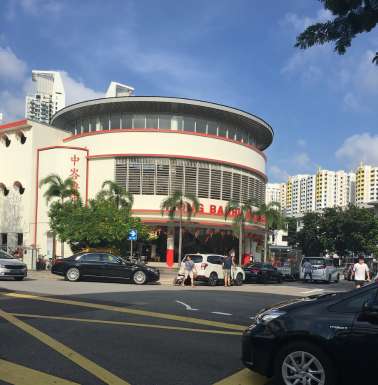

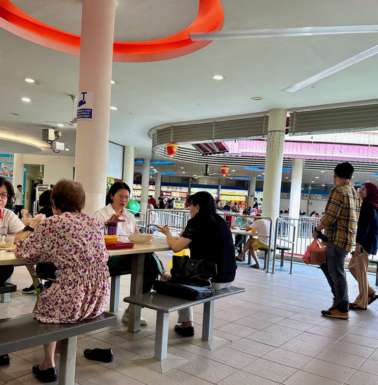
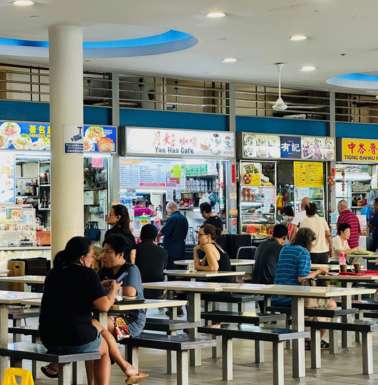
Big food halls, yes, but hawker culture is more than just a collective of stalls. A great article, “The History and Evolution of Singapore’s Hawker Culture,” on the Singapore government Roots website describes hawker centers as Singapore’s community dining rooms, and in our experience, our neighborhood center at Tiong Bahru Market was our community dining room, where we mingled with local people, and sometimes shared tables – with an older couple, a group of women chatting, a young man visiting from China, or people with work IDs clipped to their shirts.
Tiong Bahru Market’s hawker center is on the second floor, covered, spacious, arranged around a large courtyard, airy, open to nature and sheltered at the same time. If you’ve watched Somebody Feed Phil on Netflix, you might remember that the Singapore episode opens with Phil at a hawker center – it’s Tiong Bahru!
While Tiong Bahru is my favorite, I think everyone who has gotten into the Singapore hawker culture has a favorite. There are plenty to choose from – the article I mentioned says there are 110 hawker centers around Singapore, and that the government announced in 2019 that 13 new centers would be built by 2027. So, it’s no wonder that in 2020, Hawker Culture in Singapore was inscribed as Singapore’s first element on the UNESCO List of the Intangible Cultural Heritage of Humanity.
Kaya Toast and Chicken Rice
There are so many cuisines and delicious, popular foods at the hawker centers that I almost hesitate to single out just two. But of course, I will.
Kaya Toast is a long-time popular breakfast of toasted bread with butter and kaya jam, boiled eggs, and coffee. If you don’t know, kaya jam is coconut milk jam made with sugar, eggs and sometimes pandan leaves for more flavor. The way our kaya breakfasts proceeded was thus: our white bread was lightly toasted and spread with butter and jam. Two uncooked eggs went into a plastic pitcher, followed by scalding water to cook them. The first time, I didn’t leave my eggs in the pitcher long enough and they were underdone. Not cool. Thereafter, I left my eggs in as long as practicable, and it was much better. I brought back jam from both trips, and you can order it online.
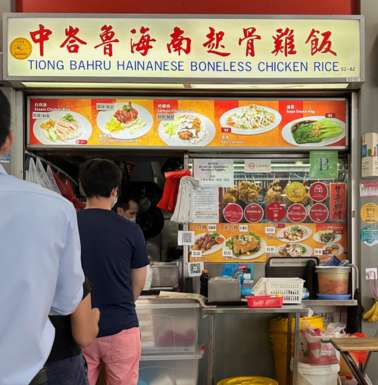
Hainanese Chicken Rice is considered by many as Singapore’s national dish.
Hainanese Chicken Rice (“chicken rice”) might be simple but is considered by many as Singapore’s national dish. It’s poached chicken and flavorful rice, maybe with some accompaniment such as cucumber and sauces. Every vendor has their own variation. I had chicken rice at Tiong Bahru Hainanese Boneless Chicken Rice, one of the seven restaurants or food stalls in Michelin’s online guide to Singapore Chicken Rice. As the guide says, the stall imply closes when the day’s chicken sells out, so come early.
Tiong Bahru – Unique in Singapore
Why focus on this neighborhood? We found it just by chance at first. As Kathy and I each did searches prepping for the 2019 Asia trip, we looked where we might stay in local hotels outside the tourist centers. In Singapore, that led to Tiong Bahru. So, we met up in this appealing neighborhood without knowing a lot about it except that the Tiong Bahru Market was exceptional, the community was architecturally significant, and the metro was close. We stayed at the small Nostalgia Hotel, just steps from Tiong Bahru Market, and ten minutes or so on foot from the metro station for city-wide access. In 2024 we chose to return to Nostalgia. And we’re not alone thinking that Tiong Bahru is a desirable place!
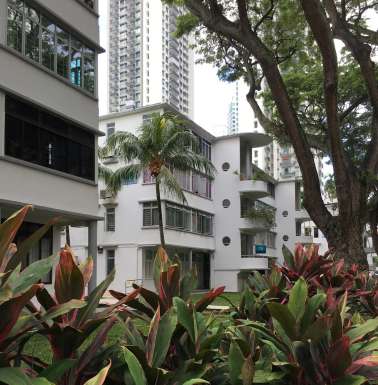
Architecture in the Tiong Bahru housing area.
Starting with the architecture, Tiong Bahru is unique in Singapore. It’s the oldest housing estate in the city, very desirable today, built by the Singapore Improvement Trust (SIT) in the 1930s, in a “Streamline Moderne” style, which is based on horizontal and curved lines, aerodynamics, efficiency. Think about those classic posters for glamorous travel in the 1930s – sleek trains, airplanes, fast cars, cruise ships, always on the move – and you’ll have the idea: long lines, nautical elements, curves, heading to the future. Sleek and simple. And in Tiong Bahru, white. The housing was intended to absorb overflow from Chinatown.
The neighborhood is popular. Green, charming, quiet, increasingly desirable, and – hip. It’s been discovered as a great place to live by expats and digital nomads. There are cool cafés and shops (I bought a lot of clothes at First Stitch down the street from the hotel), but the Singaporean population still predominates, and the neighborhood hasn’t lost its “kampung” feeling – that’s Malay for small village. It was a good place to come back to after a day of energetic touring.
On the 2024 visit, we returned to Tiong Bahru and had time to get to know the neighborhood better, its origin, history, and daily life. The self-guided Heritage Trail is an easy-to-follow path to the neighborhood’s historic and significant cultural sights. Follow as much as you like. I also suggest walking through the housing estate and simply enjoy being in a neighborhood – as I’ve said, it still has a kampung feeling.
Wall Art But No Graffiti
Add more depth to your understanding of the neighborhood by following a map of superb murals depicting “bygone days.”
There’s no graffiti in Singapore – it’s illegal and punishable. However, there are approved murals, and in Tiong Bahru, Singaporean artist YC (Yip Yew Chong), who grew up in Chinatown and had many family members in Tiong Bahru, has painted murals that tell stories of the former way of life in the neighborhood, sometimes mixed with real scenes. For more about YC and the murals, see his web site at “Art + Travel of YC.” We followed his map and located each of the insightful Tiong Bahru murals. There’s also a painted goat family in the vicinity of Tiong Bahru Market, and a giant fish swimming on a wall at the Tiong Bahru Post Office. By the way – we found people at the Post Office very helpful.
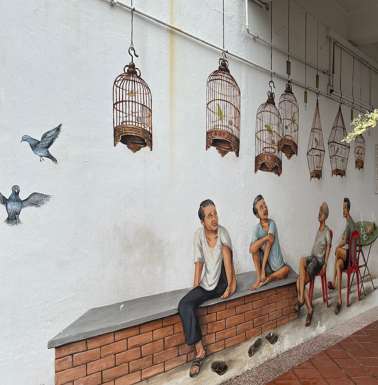
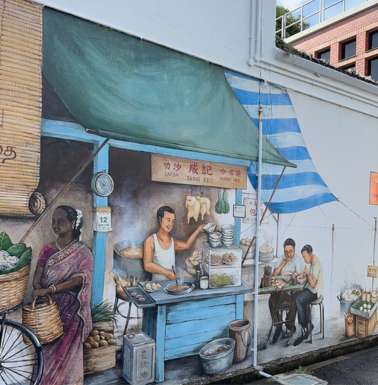
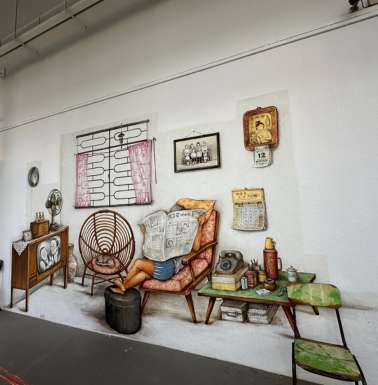
Where we ate in Tiong Bahru
The Tiong Bahru Market, naturally. The hawker market stands are generally open through afternoon, and for dinner there were plenty of casual cafés, creative and satisfying. We went to four of them most often, even for breakfast and lunch – it wasn’t always hawker center time! We liked Privé, not far from the hotel, both for lunch and dinner, and it was a great place for cocktails. Unhappily the Tiong Bahru location has closed (as of late 2024) but there are other locations. Merci Marcel is another delightful, France-meets-the-tropics venue with several locations across Singapore. Merci Marcel’s web site has a neighborhood guide on its Tiong Bahru web page – they say Tiong Bahru is a must-visit! Lucca’s Trattoria is traditional Tuscan, in Tiong Bahru for more than a decade, and adjacent to Nostalgia. Our other go-to was Tiong Bahru Bakery, another café with several locations. It’s a French style bakery with the expected breads and pastries along with other creative options and really good coffee. Very good! Popular! The line was often long, so timing was important. A great start to the day.
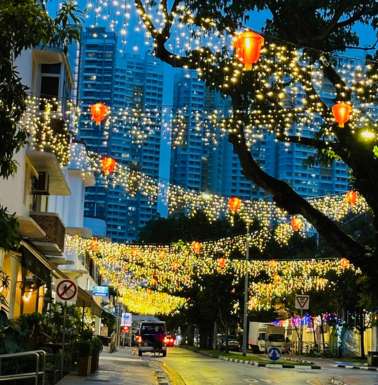
The streets of Tiong Bahru are beautifully decorated.
Feeling at home
I enjoyed reading again about Tiong Bahru as I recapped the trip. We found it all the things I’ve read about – creative, hip, quiet, architecturally important, a museum of wall art, all things I like. It was an easy neighborhood to fit into, to feel welcome, find favorite walks, cafés, heritage locations, and of course there’s one of the best hawker centers in Singapore. If you have limited time in Singapore, of course see the big sights first. But if you are interested in local history or architecture or just want to get a feeling for a thriving, attractive Singapore neighborhood and have a good lunch besides, you couldn’t beat spending at least part of a day in Tiong Bahru.
Citation
